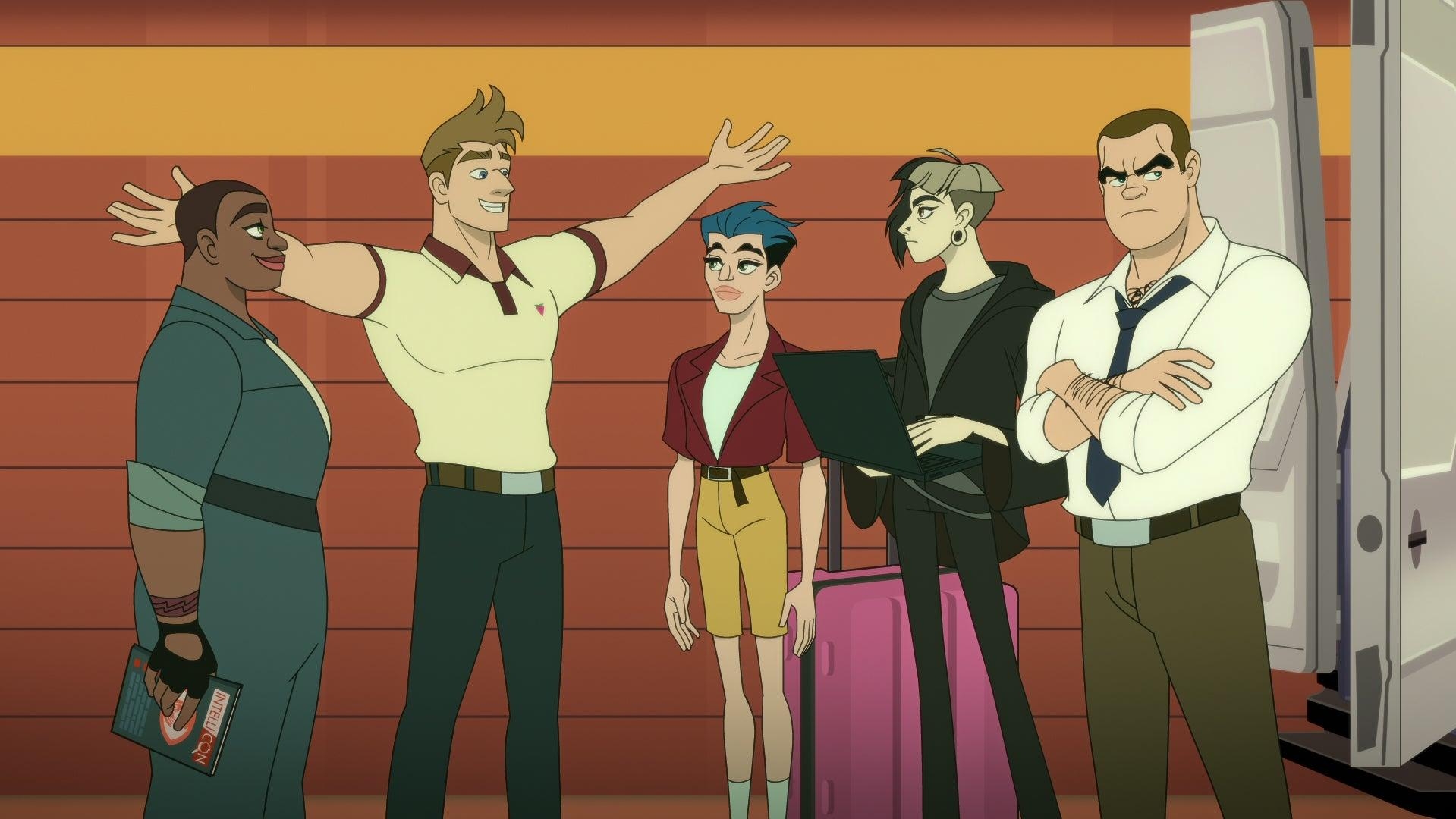Netflix’s Q-Force is as soulless as a Drag Race acting challenge
The new adult animated series has nothing to offer but lazy cultural references and dated observations about queer people

To watch Q-Force, Netflix’s latest adult animated series, is to sit through 10 episodes of scripted material at the same level of quality as RuPaul’s Drag Race’s acting challenges, where talented performers try to bring to life a script with no actual jokes, just cultural references. It’s like scrolling through the drafted tweets of Gay Twitter Comedians or sifting through the outtakes for a gay podcast, where every other sentence in a conversation involves a name-drop of a pop star or actress and a catty observation about them.
The series follows a group of gay spies who work for the fictional American Intelligence Agency (AIA). The leader of the group is Steve Maryweather (Sean Hayes)—referred to primarily as “Mary,” because Mary is a name used to ridicule gay men, get it?—who spends his days trying to prove his worth and that of his team. This merry band of queer misfits includes Stat (Patti Harrison), the hacker; Deb (Wanda Sykes), the mechanic; Twink (Matt Rogers), the master of disguise and drag queen; and the token straight agent Rick Buck (David Harbour). They dive into adventures under the supervision of V (Laurie Metcalf) and in spite of the overwhelming contempt and hatred that AIA Director Dick Chunley (Gary Cole) has for queer people.
It seems unfair to call Q-Force dated, when it was likely put together quickly to have its finger on the pulse of the queer zeitgeist, but it’s hard to find any jokes that don’t rely on observations about queer people that have been around for ages. The show’s brand of humor involves reminding you that lesbians love doing things like book a U-Haul, watch Carol, wear Birkenstocks, and listen to Tracy Chapman’s “Fast Car.” The writing staff recreates scenes wholesale from movies and try to pass them off as witty, much like the worst Family Guy episodes. In two of the most egregious examples, Laurie Metcalf recites an extended bit of dialogue from My Cousin Vinny for lesbian trivia, and the always reliable Stephanie Beatriz voices a character who is literally just Mia from The Princess Diaries, except she says “fuck” a lot. Every line that doesn’t serve as exposition is another reference, be it something relatively fresh and niche like turning Natalie Portman’s Vox Lux character into a Eurovision singer named Vox Tux, or something as irrelevant as a straight man farting and talking about how they should put up a poster of Carmen Electra in the year 2021.
Any time the series wants to make a statement about how queer people are treated within the contemporary cultural landscape, it undercuts itself by reinforcing whatever stereotype it was quick to joke about. There simply isn’t anything intelligent or funny in the observations being made, but creator Gabe Liedman and executive producers Michael Schur and Sean Hayes want to have their cake and eat it too. They want Q-Force to be a progressive series, one that proves that anyone can be a spy and that all sorts of queer people can show their use. But, much like Brooklyn Nine-Nine (which Schur co-created and Liedman worked on), the series has difficulty being critical of anything it depicts; Q-Force makes jokes about brands like Citibank pandering to gay people at Pride and how the American government hates gay people, while also casually reinforcing homonationalism at every beat.
Despite its stated intent to explore these characters who were rejected by the spy community for being queer, the series barely gives them any personalities of their own. The talented voice cast is wasted; performers like Sykes and Harrison have gotten better material on other shows (The Good Fight, Shrill, The Other Two, and I Think You Should Leave just to name a few). What few genuinely compelling story arcs exist (Stat’s brief relationship with an AI named Jacqueline, and V’s background at the AIA) are sidelined for the sake of more quips about how gays and lesbians act. The character designs are as uninspired as most adult animated shows these days (with some actors literally just appearing as animated versions of themselves)—not so much ugly, but not exactly appealing to look at or even the slightest bit visually ambitious. Netflix’s work with the animation studio Titmouse, Inc. has offered varying degrees of quality, from the purposely grotesque puberty exploration of Big Mouth to the beautiful surreal realms of The Midnight Gospel, but everything about Q-Force’s style feels lifeless. Outside of Twink’s various costume changes to perform in drag, there isn’t anything unique to any single figure.
Nothing about Q-Force really stands out, especially in a world where a number of genuinely good animated series for adults exist. It doesn’t have the joke-writing, world-building, or character development that comes with shows like The Venture Bros. or Harley Quinn, or the irreverent spirit and willingness to go for broke, even when it fails, of Rick And Morty. A show like Drawn Together, which was chock full of offensive humor, feels more subversive and progressive despite having premiered nearly 20 years ago. Even Q-Force’s centering of gay spies (according to the series’ creators, the intelligence community represents one of the last bastions of masculinity unexplored by queers) fails to ring original, six years after the premiere of Tom Rob Smith’s brilliant limited series London Spy.
One could deride Q-Force by calling it a show made for people who beg for more mediocre gay mainstream movies without actually looking for good queer art, but even those viewers will see through its woke façade. In spite of being created by a number of queer individuals, the series’ much-touted representation is mostly lazy stereotypes and dialogue, less designed for incisive storytelling than promoting a brand’s purported inclusivity.